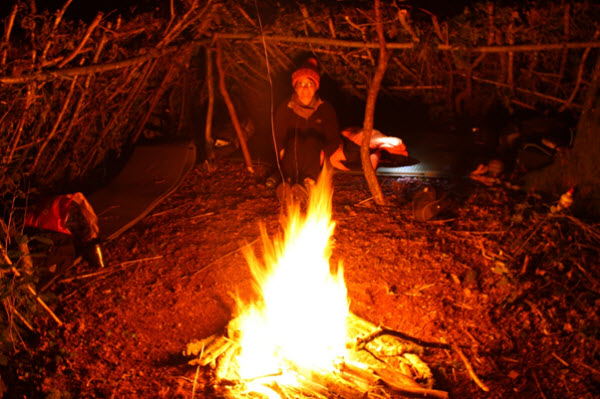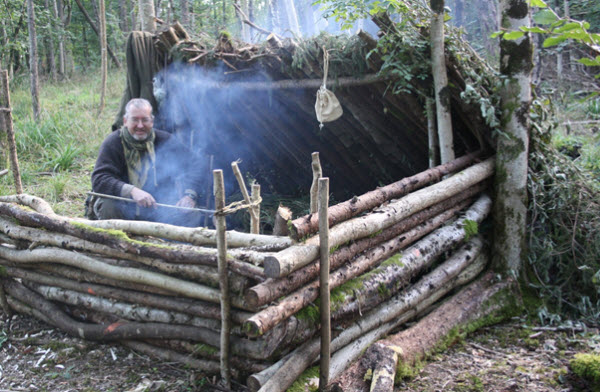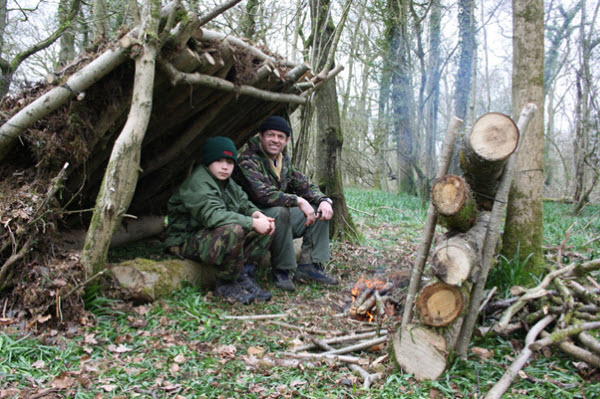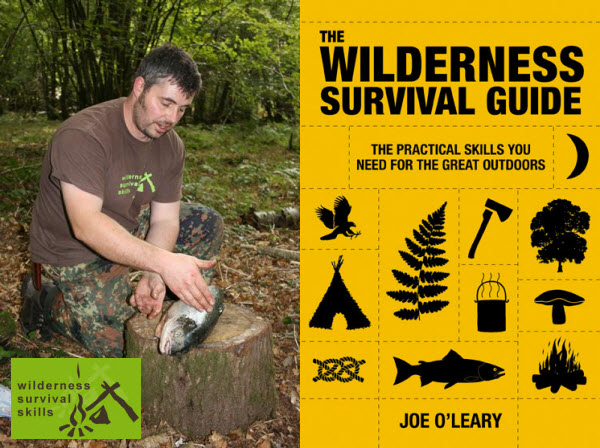Providing or seeking shelter is often a wilderness survivor’s first priority after removing themselves from immediate danger. Many hill walkers and outdoors folk go equipped for an unexpected night out whenever venturing out into the wilds, carrying lightweight shelter systems, a heat source, warm clothing, energy giving snacks, simple lightweight cooking equipment and water. However, if you were unlucky enough to be faced with a night out at the mercy of the elements without any emergency kit then having previously considered a sound strategy, prioritizing your essential needs would be time well spent. With the right warm and weatherproof clothing, additional improvised shelter might be all that you require but in very cold conditions with inadequate clothing to see you through the night, a quick and effective shelter design requiring minimal energy investment that also allows for additional warming via a campfire would be the order of the day.
Recently, myself and my fellow instructors set off on a self-imposed week away with very little kit and virtually no food with the intention of effectively practicing what we preach. Personal challenges such as this are vital for proving, or dis-proving theories, gauging progress and highlighting any areas that need work or improvement. Our basic kit consisted of the clothes we stood up in (no Gore-Tex waterproof jackets though), a small belt knife, folding saw, metal cooking pot, 2 metres of strong cord, a cloth bag for filtering water and a small amount of venison. Therefore providing effective shelter and warmth using only these few tools and the surrounding natural resources before night fell became an absolute priority. To add a further element of difficulty to the proceedings, we were all to complete the week alone increasing the initial workload and raising a whole load more personal challenges. I should point out at this stage, that this was a controlled experiment and we all had provisions within reach in the event of an emergency. Anyone ‘cheating’ would only be cheating themselves…
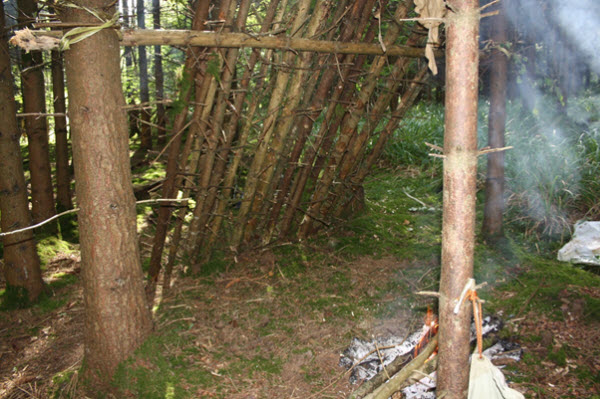
A basic structure can be put up very quick in the right location. Note the use of dead wood only for ridge pole and rafters with green hazel withy bindings holding everything in place.
So, to summarize; the bad news was that we were all facing seven days and nights outdoors with no waterproof clothing, sleeping bags, stoves and tents in late autumn, however the good news – we did have some basic tools, practical knowledge of using the local resources to provide everything we would need, the desire to go beyond mere survival and make ourselves relatively comfortable and a whole day to put our strategy into action. While providing shelter is almost always a priority (and if we were all going home/getting rescued the following morning that is where all our energies would have been invested) on this occasion, building a shelter was sitting in pole position alongside building and lighting a warming campfire.
With no matches, lighter, fire steel or any other method of ignition other than constructing a bow drill (fire by friction) this task was going to take some time and a certain amount of energy expenditure. If left until later in the day, or even the following day, energy levels would be much lower and success looking a bit less of a certainty. No fire would mean very cold nights with minimal sleep, no way of making the stream water safe to drink, no cooked food.. a pretty miserable week in the woods! So, although we had all day to provide the essentials, with the need for a fire ranking so highly plus the fact that we were working completely alone, this made the need for a quick but effective shelter all the more important. We all (completely independently) opted for a simple Lean To design. It’s quick and easy to build (around 90 mins to two hours if you choose the right location), suits many different environments and materials, can be safely heated by a campfire, can often be built without the need for a cutting tool and easily added to if your particular situation requires a larger shelter as the days go on. Although there are many other shelter designs which look ‘prettier’ the Lean To ticks all the boxes for a shelter to match your survival strategy. Here are a few top tips for building one ….
- Once you have chosen a suitable site, ideally with a couple of suitable trees to act as supporting posts for your main ridge pole, you must consider the prevailing wind direction. If you have a choice then you should aim to have the wind hitting the back of your shelter rather than blowing straight in the open front. If you have the means and ability to light a fire then it’s a good idea to angle the shelter slightly to have the wind coming from side on but still from the rear. This should carry the campfire smoke away and prevent a billowing ‘eddy’ of smoke being blown straight back at you all night long.
- Take some time to properly measure your sleeping area and ensure that your shelter won’t be too small once it’s built. In miserable weather you may need to use it’s cover to shelter during the day too while you cook and carry out other tasks so adequate room to work, as well as sleep is important. Another vital dimension to build in is the distance between your bed and the campfire. This should be a full pace or around a metre. Any further away and you’ll need a bigger fire to warm you (which just means collecting more firewood) and any closer and you’ll roast, probably along with the shelter thatch.
- If you’re up against a time deadline (usually the setting sun) it’s well worth spending what daylight you have left collecting and stockpiling building materials. Then if night falls annoyingly fast as is usually the case in the woods, you can still cobble something together in semi darkness that should provide adequate protection for the night.
- Consider the strength of your building materials. Ideally your main horizontal ridge pole should be able to take a hefty person’s weight. This seemingly over enthusiastic safety precaution allows for the combined weight of your rafters, your thatching materials, the added weight of the thatch when rain soaked or covered in several feet of snow and also the force of the wind against your makeshift structure. As already mentioned, your lean to will be much more stable if the two main posts are comprised of existing, well rooted trees – far sturdier than two forked sticks dug into the ground. Look for two correctly spaced trees with sturdy branches jutting out from the trunks at about chest height, facing into the prevailing wind. Your ridge pole can sit atop these branches with the weight of the shelter rafters and thatching material pushing it snugly against the trunk. A very strong and secure arrangement with no need for cordage and lashings. It’s worth looking around to maximise what your environment has to offer. If your chosen trees don’t have convenient supporting branches then you may need to lash your ridge pole in place with strong cordage or improvised bindings such as flexible coniferous tree roots, strips of willow bark or twisted ‘withies’ of green hazel. Either way, it’s vital to ensure that your main ridge pole is placed on the correct side of the trunk so as to allow the shelter’s weight to push the ridge pole against the trees rather than push it away, thereby putting all the strain on your lashing. Leave a good overhang at each end to eliminate any danger of your ridge pole slipping out of it’s mountings.
- Rafters should also be strong, ideally around wrist thick. In wild, un-managed woodlands you should have a certain amount of standing or fallen deadwood of all shapes and sizes minimizing the need for a cutting tool (just push them over like a bear then slot them between two sturdy trees and bend, eventually snapping them to the desired length). If you’re lucky enough to have plenty of long, straight timbers then these can be placed almost touching side by side to provide a good, solid roof but when building materials are in short supply, opt for a strong rafter every 30cm and fill the gaps with smaller section stuff. Contrary to popular belief, each and every rafter does not need to be lashed or woven into place. Use the hooks and protrusions found on most natural materials to your advantage in ‘locking’ the structure together and make sure all rafters over sail the ridge pole by a good margin to avoid collapse when under strain. Gravity and the weight of the thatch will then hold everything securely in place. If time allows, continue bringing the rafters around both sides to stop wind whistling through your bed chamber.
- With the main structure sound and completed, you can now start adding the thatching materials. Expect this job to take almost as long as the structural phase, if you want your roof to shed the rain that is (which is sort of the point). The basic rule of thumb here is that if your thatching material doesn’t look particularly water resistant then aim for a steeper pitch angle of between 55 – 70 degrees when placing your rafters. The more water resistant your chosen thatch, the less steep your pitch needs to be but regardless of what materials you have available, work to a minimum pitch of 45 degrees or you’ll be asking for trouble when the soggy stuff hits. Thatching materials vary greatly depending on location but are always laid on at ground level and built upwards to allow each layer to overlap the previous one, similar to roof tiles. Large leaves, turfs, reeds, bark slabs, spruce and fir boughs, brash wood and leaf litter or a thatching cocktail of all of the above should do the trick. Even large animal hides were used in days gone by. It’s very easy to reach a point where your shelter looks complete from the outside however, an experienced shelter builder judges a weatherproof roof from the inside. It must be dark as a dungeon inside with no chinks of light showing through the thatch. If light can penetrate then so can rain! Lastly, ensure your thatching completely covers the ends of the rafters. Any protruding rafters will catch the rain and channel droplets down the underside to drip onto you all night long.
- Assuming you have absolutely no sleeping equipment at all, you’ll need insulation from the warmth sapping ground and in cold conditions, external warmth in the form of a fire. Ground insulation can be as simple as deep layer of springy twigs held in place by a single log acting as a retaining wall, then covered with a good thickness of soft, dry plant material. This natural mattress should be aired and added to every morning. Or if you have enough time and cutting equipment an initial platform of long poles sitting on top of a large log at each end will lift you up off the ground, allowing warm air from the fire to circulate underneath you and providing a comfy ‘bench’ to take the weight off your feet during the day. This long pole bed will still need a good thickness of dry foliage on top for comfort and insulation.
A good fire in front of the shelter will provide warmth through the night as well as a means of cooking food, sterilizing water, lighting the darkness and keeping beasties away. A fire radiates heat out in every direction so box it in by building a simple stacked log wall on the far side to bounce most of the radiated heat back towards the shelter. Firewood and dry kindling can be kept under the lee of the shelter or in the dry, warm space under your long pole bed. Choose your firewood carefully so as to get good, steady heat through the night and ensure you have a good stash close to hand so when you get woken by the cold during the night, all you need to do is reach out and plonk a couple of good logs on with a handful of smaller kindling then drift off to sleep again, warm and cosy.
The beauty of the Lean To is it’s simplicity combined with it’s effectiveness as a survival shelter. Once the basic principles have been absorbed and understood they can be applied to many other circumstances. Two Lean To’s facing each other with a fire between them provide a very warm and weatherproof set up for two people. Build the roof on the prevailing wind side higher to over sail the opposite shelter and you have a ‘cowl’ like effect where the fire is protected from the rain but smoke can still escape easily. Several Lean To’s in a circle all facing inwards make a group shelter providing almost complete protection from the elements. Group shelters allow weaker and more vulnerable group members to be easily observed and catered for. The fully enclosed fire draws much more efficiently sending the smoke straight up out through the smoke hole. Less fuel is used and everyone benefits from the heat of that one fire, thereby sharing the firewood collection. It’s a win win situation! There are many short and long term shelter variations all based on the humble Lean To principles. I’ve always felt that it’s better to learn a handful of useful skills and truly master them than a whole truck load of skills that you haven’t had the time to test and can’t possibly remember. The Lean To is the perfect example of this philosophy.
By the way, we all survived our week in the wilds. In fact, we were perfectly comfortable. For many of us, the only shelter improvements necessary were to minimize heat loss by building better, fully enclosed log wall fire reflectors. Opting for a Lean To shelter meant that we had taken care of that need immediately needing no further time spent making something bigger or more fancy. Instead we were able to begin crafting primitive hunting weapons, make clay bowls, weave food gathering baskets…but that’s another story.
Joe’s book ‘The Wilderness Survival Guide’ is available on Amazon and other well known book shops and fits nicely in your average Christmas stocking. Courses are also available in Wiltshire covering everything from foraging and fire lighting to making buckskin clothing and flint tools. Please visit www.wilderness-survival.co.uk
